V.

Overstimulated Civil discourse, pg. 6
Energy drinks, pg. 18
Trans budget cuts, pg. 20

October 2025 Volume 27 Issue 1



Overstimulated Civil discourse, pg. 6
Energy drinks, pg. 18
Trans budget cuts, pg. 20


Palo Alto High School senior Juli Spreckelmeyer holds an energy drink in an edited photo taken by Editor-in-Chief
Kensie Pao. Illustrations of pink lighting bolts and blue detail, drawn by Art Director Ethan Bradley, shine out from the Red Bull, representing the high energy in this issue’s stories.
Publication policy
Verde Magazine, a news and features magazine published by the students of Palo Alto High School’s Magazine Journalism class, is a designated open forum for student expression and discussion of issues of concern to its readership. Verde is distributed to its readers and the student body at no cost.
Letters to the editors
The staff welcomes letters to the editors but reserves the right to edit all submissions for length, grammar, potential libel, invasion of privacy and obscenity. Send all letters to verdemagazine1@gmail. com or 50 Embarcadero Rd Palo Alto, CA 94301.
Advertising
The staff publishes advertisements with signed contracts providing they are not deemed by the staff inappropriate for the magazine’s audience. For more information about advertising with Verde, please contact our business manager at verdebusiness5@ gmail.com.
Printing & distribution
Verde is printed five times a year in September, November, February, April and May by Folger Graphics in Hayward, California. The Paly Parent Teacher Student Association mails Verde to every student’s home. All Verde work is available at verdemagazine.com
Editors-in-Chief
Chloe Huang
Kensie Pao
Managing Editors
Eva Chang
Lilia Kuzmicheva
Lara Saslow
Features Editors
Chris Jeon
Ryan Saket
Profiles Editors
Lilo Sayag
Yardenne Sternheim
Culture Editor
Tessa Berney
Perspectives Editor
Stefan Eriksson
News Editors
Leela Kulkarni
Julie Yang
Editorials Editor
Eva Chang
Launch Editor
Keira Ling
Cover Director
Yardenne Sternheim
Webmaster
Ethan Zhang
Art Directors
Ethan Bradley
Lilia Kuzmicheva
Photo Director
Shaurya Thummalapalli
Manager of Business Operations
Stefan Eriksson
Social Media Managers
Ananya Adya
Angela Fang
Staff Writers
Jacob Domingo
Jaron Leung
Ryan Shin
Adviser
Paul Kandell

With so many changes affecting our lives as students, it’s easy to feel overstimulated. When exploring the effects of energy drinks, which are widely consumed by Palo Alto High School’s student body, we realized the fast pace of our world around us fit this issue’s theme: overstimulation. With events like Charlie Kirk’s assassination, changes to the college admissions processes and new phone policies in classrooms, “overstimulated” is certainly how our staff has felt since returning from summer break.
Our editorial “The price of speaking out” shares Verde’s views on Kirk’s death. As a staff, most of us did not agree with many of Kirk’s opinions, but we do not condone a person’s death for any reason, especially when it relates to expressing free speech. This is extremely immoral, and contradictory to our democratic values.
Energy drinks are a common stimulant used by many students. “Buzz Kill” by Keira Ling and additional reporting by Ryan Shin explores the negative effects associated with these drinks. With energy drinks being so prevalent in youth culture, we see teens making it part of their daily routine and ignoring the consequences that widespread usage exposes them to.
Changes within college legacy admissions are addressed in a news story written by Ryan Saket. In response to Stanford University’s recent decision to bring back legacy admissions, we as a publication believe this provides an unfair advantage to students without familial connections, as is explored in our Stanford legacy editorial.
With the Trump Administration responsible for many changes our country is undergoing, the clash of opposing ideas is often fought through protests. Thousands of people came together on the Peninsula on Labor Day to express their opposition to the administration. The 17x17k protest, which aimed to create a 17-mile-long human chain along El Camino Real with a group of 17,000 protestors, is covered in “Protest Against the Powerful” by Leela Kulkarni and Shaurya Thummalapalli.
With all the changes and overstimulation we face, it can be hard to stay centered. We hope that this issue informs you of our current state as teens living through a time of tremendous social and academic change. In all the chaos, one thing remains clear: our generation is paying attention.
CHLOE, LILIA, KENSIE, LARA


WHEN ATHENS sentenced Socrates to death in 399 BCE, it wasn’t for the typical reasons at the time. He was sentenced to death not for violence or corruption, but for “leading the youth astray” with his questions, according to McGill University. Millennia later, Charlie Kirk, though far from a philosopher, met a similar fate after building his platform on mobilizing young conservatives.
Of course, Socrates and Kirk lived in very different worlds. Socrates was sentenced to death by the Athenian state after a public trial; Kirk was assassinated by a lone individual. Their legacies are also quite different. While Socrates laid the foundation of Western philosophy, Kirk was a controversial and polarizing political activist. We are not comparing these men in any regard other than the pattern they both fell victim to: societies turning to violence in response to ideas they find threatening.
Like Socrates, Kirk disrupted the current establishment. On college campuses where conservatives have long felt outnumbered, he challenged mainstream narratives and helped energize a movement that played a decisive role in President Donald Trump’s 2024 presidential victory. Both men, in their own ways, were punished not for crimes, but for the words they spoke.
Authorities have charged Tyler Robinson with Kirk’s murder based on evidence which suggests that political animosity was Robinson’s primary motive. Verde acknowledges that there is a legal process underway, and that we do not currently have enough information to decisively dictate that Robinson was politically motivated.
Verde does not endorse Kirk’s ideas. In fact, many of us strongly disagreed with his stances. However, disagreement is not the point. In a democracy, the right to voice one’s beliefs, regardless of whether they are popular or unpopular, must be protected. If Kirk, a man who embodied the voicing of unpopular opinions, was murdered, then what’s next? Silencing students who speak out? Censoring journalists who write un-

comfortable truths? Targeting activists who challenge authority? If we accept assassination as an answer to disagreement, we accept the erosion of democracy itself.
Today’s society often sustains a climate that compels individuals to self-censor their ideas in favor of preserving their social status—a troubling development occurring in schools across the nation. The simple act of voicing an opinion during class discussion has become increasingly difficult for some, as students fear judgement from their peers. According to the Foundation for Individual Rights and Expression, only 9% of college students expressed their true opinions during class discussions.
Additionally, within an hour of Kirk’s death, the video of his assassination had already circulated throughout Palo Alto High School via social media. The reactions around school mirror our current divide: some were horrified, while others celebrated. If students already treat politics like a video game where opponents’ deaths
are considered victories, what does this say about the future of our democracy?
In a democracy, if you can’t win at the ballot box or in a debate, the answer is never to silence the opposition through violence. This is why civil discourse is more important now than ever. We as citizens must recall how to look beyond our echo chambers, debate openly and maintain a key distinction: we are humans first. People may hold differing opinions and ideas, but that does not make them inherently evil. It is harmful action, not beliefs, that must be judged.
History shows us what happens when societies fail to make this distinction. Socrates’ death proved that even the birthplace of democracy could betray its own principles. Now, more than 2,000 years later, our generation must finally defend what Athens failed to protect: the right to disagree peacefully. v
ON JUNE 6, 1963, in a commencement address at San Diego State University, President John F. Kennedy told thousands of gathered college students that while “not every child has an equal talent or an equal ability or an equal motivation, … they should have the equal right to develop their talent.”
At the time, Kennedy was addressing the divisive racial disparities in education. If his declaration is to come true, students should not have the unfair advantage of being admitted to colleges on the basis of their family’s attendance history.
Despite growing opposition to the practice, a controversial statement released in August revealed that Stanford University would be renewing its commitment to family-based acceptances for the coming school year as a part of its 2026 admissions criteria. Stanford’s decision to maintain legacy guaranteed the school’s withdrawal from the Cal Grant program, a program that provides state-funded financial aid to low-income students, and prohibits participating colleges from giving advantages based on alumni status.
Equal opportunity in higher education cannot exist if family connections give students an advantage in the admissions process, as this practice rewards privilege while limiting access for students without family history within the institution. We believe Stanford should end legacy admissions in order to ensure equal fairness for all stu dents, and that college admissions should reflect academic ability — not familial con nections.
cy. According to an anonymous Palo Alto High School stu dent with Stanford legacy, resistance to legacy admis
sions overlooks the importance of familial bonds the system creates within college populations.
“Having legacy within … schools creates a community aspect,” the student said. “It makes [college] like a family. I think that’s really important to maintain.”
The student also noted that colleges’ devotion to legacy admissions stems largely from financial reasons, with the descendants and siblings of alumni generally being wealthier and, as such, more likely to be full pay.
“Part of why legacy students get into schools is because schools can be certain that they can pay,” the student said.
While both points are true, they don’t necessarily paint a full or comprehensive picture of the admissions process. Communities and bonds can be formed in many different of ways, and there is no guarantee that students will bond better simply because their parents are both alumni. While it’s true that legacy students tend to be more financially stable and more likely to afford full tuition, full-pay students and legacy applicants are not synonymous with each other, and the fact that schools are heavily reliant on applicants paying in full for funding is more indicative of the outdated financial backings in higher education than anything else.

62 years have passed since Kennedy first declared his intention to ensure equality in education, but there’s still work to be done. American children can never truly receive an equal chance at education if some are preferred over others due to familial ties. v
Art by LARA SASLOW

With ASB Spirit Commissioner Arabella Guinle

Q: What is ASB planning for Spirit Week this year?
A: “ASB is arranging quite a lot, from our usual activities like our daily rallies and best dress-up days to our new additions since last year—night rallies, class floats and class dance rehearsals ... We are trying to incorporate a mix of new games and old games that we know students love, and are super excited to see everyone’s thoughts on them this year at the rallies. We also incorporated a new system for demos of games at rallies. For inside rallies in the gym, we will be showing tutorials of the games on the projector instead of doing live demos.”







Text, art
and
design by KEIRA LING



Ms. Juan Mr. Davis Ms. Williamson
Verbatim: What are your thoughts on SAT and ACT requirements?

“The exam is not very accessible to everybody … It might create some financial and geographical barriers for students, which may make them unable to apply to colleges if they don’t have a score.”
— Raymond Zhou, senior

“If I do really bad on the SAT and don’t want to put my score, it can affect me negatively.”
—
Bill Dang, sophomore


“If you’re not at a socioeconomic level that allows you to be eligible for the free SAT, it will put you at a disadvantage because you’re stuck in a limbo where you can’t send in a score.”
—
Maya Cheng, junior
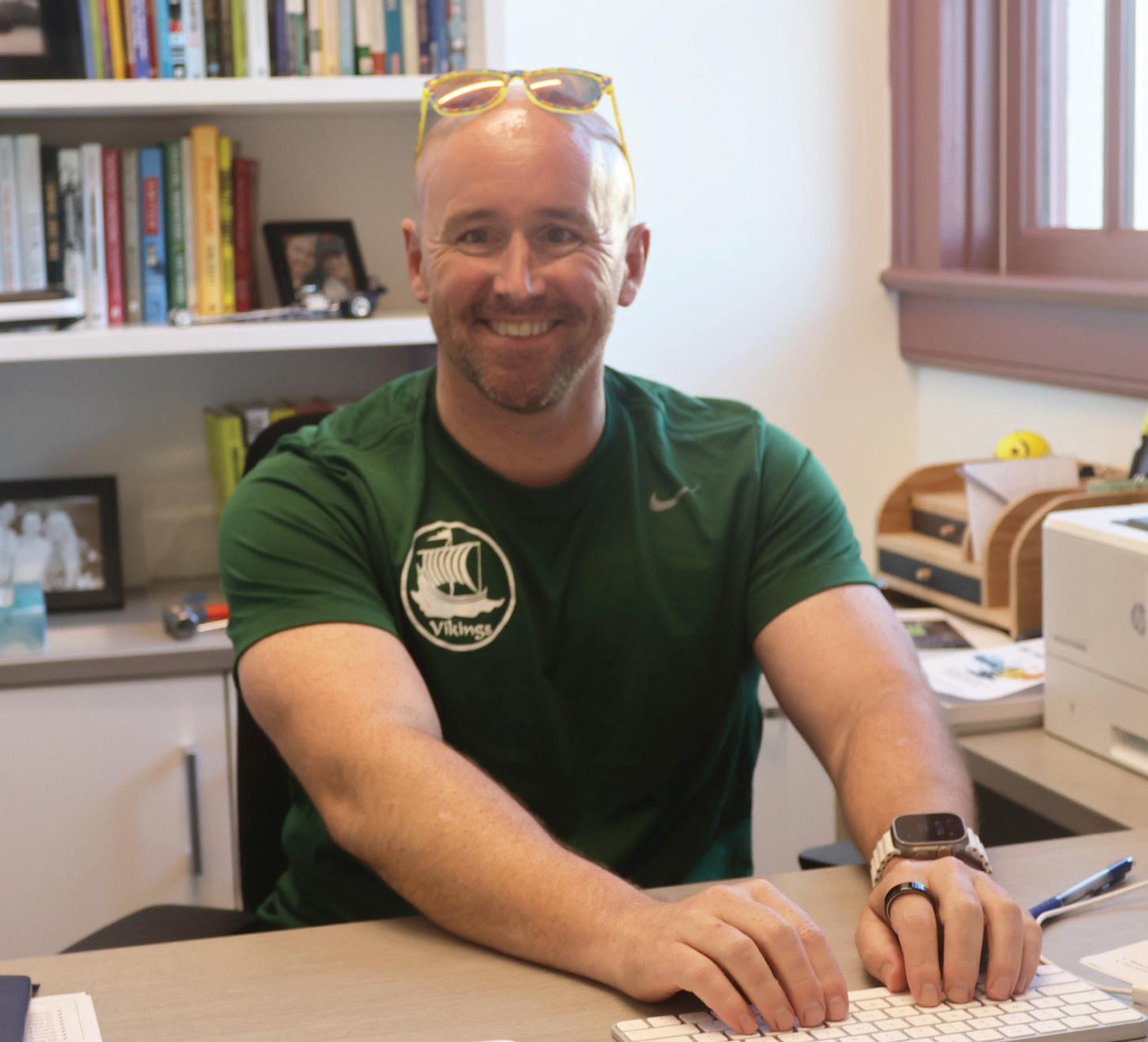
Michael Stieren joined the Palo Alto High School Administration team this year, and says he is excited to get to know the student body.
The new assistant principal aims to collaborate with faculty and oversee student services such as the Advanced Placement Capstone program, the Speech and Debate Team, the Robotics Team and others.
While this is Stieren’s first year working at Paly, he’s no stranger to the Bay Area. Stieren was the vice principal at Adrian Wilcox High School in Santa Clara for four years, and grew up in the Bay Area. In an interview with Verde, Stieren even recalled playing a baseball game against Paly in 1997.
When Stieren is not engaging with his new colleagues, he says he loves walking around the school, receiving movie and
music recommendations from students.
One thing that stood out to Stieren in his first few weeks is the energy radiating from students.
“No two days are really the same, but it is a lot of fun to just engage with different kids who are interested in different things, and hear their stories and what they're hoping to achieve,” Stieren said.
In the future, Stieren is focused on learning about Paly’s identity.
“It's important to just get to know the culture of the school, get to know the students, get to know the staff, the faculty, and sort of embed yourself into it,” Stieren said. “I'm not here to upend things and make changes. I'm here to be a good partner in the really good work that's already happening.”
by TESSA BERNEY and ETHAN BRADLEY
With construction completed over the summer and departments beginning to move into the facility, Palo Alto’s new public safety building will officially open later this year.
Located on 250 Sherman Ave., next to California Avenue, the new three-story building began construction in 2021.
It will encompass many agencies including the city’s police department, which is relocating from its old Downtown location.
Project architect Colette Chew said the old police station’s limitations were a reason for relocation.
“The existing police station was built in the early 70s, and it doesn’t meet the current code for an essential service building,” Chew said.
An essential service building must be able to withstand disasters and emergencies a standard that the new police station will be able to meet, according to Chew.
Lieutenant Nicolas Martinez from the Palo Alto Police Department noted the convenience of having several divisions of the department under the same roof.
“The new public safety building houses the police department, fire administration and the office of emergency services,” Martinez wrote in an email. "This allows the department heads to meet in one place, which in turn allows decisions to be made in a timely manner."
As teams work to move into their new site, the old police station location is currently being evaluated for a future project.
“We hired a consultant to do studies on what to do,” Chew said. “We don’t have any decisions yet, but we are surveying the space.”
by ANANYA ADYA
Edited and designed by LEELA KULKARNI and JULIE YANG
Palo Alto High School’s Homecoming dance has been moved to Oct. 11, setting the stage for Spirit Week starting on Oct. 13, featuring games, night rallies and activities throughout the week.
The Homecoming dance was moved to Oct. 11 due to a scheduling conflict with Stanford’s parking event.
“If we were to have done it [Homecoming] at the end of the week it would’ve conflicted with Stanford parking, which
ASB uses as a major fundraiser opportunity to help support huge events like spirit week,” Associated Student Body Spirit Commissioner Arabella Guinle said.
Another major addition to this year's Spirit Week rallies are the student section leaders who will help lead the games.
“Sometimes not every class council is comfortable with leading cheers and would prefer someone else in their class to lead them, which is why we made the system to
hopefully make each student section more hype,” Guinle said.
ASB is also planning another night rally, similar to last year’s rally which featured games like tug-of-war and a mini capture the flag. This event is part of an effort to turn the night rally into a yearly tradition.
“We aren’t too set in stone for any dates or logistics yet, but we are planning for it to happen,” Guinle said.
by LILO SAYAG
Palo Alto High School seniors are navigating new challenges in the college admissions process this fall as some universities have changed their policies.
Stanford University administrators announced that they are continuing legacy admissions through fall 2026.
By doing this, in accordance with a new state law passed in 2024, Stanford has chosen to forgo the state’s Cal Grant program to maintain legacy preferences. Stanford will cover the cost of their lost funding with their own resources.
Senior David Zou doesn’t support legacy admissions, but acknowledges why many universities use them to secure donations and financial support from alumni.
“I think legacy is kind of unfortunate, but it's sort of just a
thing they [universities] have to do financially,” Zou said.
Other universities in California are also changing their policies. The University of Southern California implemented an early decision this year for their business school, the Marshall School of Business, after previously only allowing early action.
While the changing application policies can make the process stressful, Paly college advisor Sandra Cernobori assures students that Paly college counselors are here to help and support everyone.
“Some kids are ahead of the game, and then there are other people who are just now starting to think about what they might do [after high school], and everything in between,” Cernobori said. “We're here to help everybody.”
by RYAN SAKET
The City of East Palo Alto has announced the opening of a pedestrian overcrossing to the public at University Avenue and Highway 101, aiming to prevent collisions.
The project aims to improve safety after 26 bike collisions occurred within one block of University Avenue and Donohoe Street between Jan. 1, 2024, and June 18, 2025. The City of East Palo Alto raised $15 million to fund the project in December 2022.
According to East Palo Alto City Engineer Anwar Mirza, even though construction is still occurring nearby, the pedestrian walkway is safe and available to the public for use. Mirza estimates the entire project to be complete by the end of September.
Access to the overpass from Woodland Avenue is on the Four Seasons Hotel side, and the entrance on the Donohoe Street side is across from Ikea.
Members of the community feel much safer traveling across University Avenue.
Sofia Zamora, a student at St. Elizabeth Seton School in Palo Alto, recalls her experience trying to cross from Donohoe Street to Woodland Avenue before the overpass was built. Prior to the structure, pedestrians used a narrow sidewalk with no guardrails to protect them from cars.
“I’ve only walked this [overpass] once," Zamora said. "Before, we had to try to stay on the line that [separates the cars and the wall]; You just stay there and go fast.”

by TESSA BERNEY
Alocal nonprofit that provides support for immigrant groups is stepping up its advocacy following a rise in local immigration enforcement by Immigration and Customs Enforcement.
The organization, Faith in Action Bay Area, coordinates legal and community assistance for individuals and families affected by ICE through a program called the Rapid Response Network, which provides quick support to those who have been arrested or detained.
Faith in Action’s organizers, who are immigrant women from San Mateo County, created the Rapid Response Network in 2016 following the election of President Donald Trump.
Nani Friedman, the organization’s research, policy, and communications organizer, said that the women were inspired by crises they lived through and wanted to support other immigrants going through similar experiences.
“These women had experienced ICE
coming to their houses and detaining family members, so they came together,” Friedman said. “They thought, ‘hat are we going to do to support other families who are in fear, and how can we create something that can help other people?’”
ICE detained about 59,000 immigrants nationwide in 2025, a 50% increase from late 2024, according to VisaVerge. In response, local organizations such as Faith in Action say they are expanding efforts to provide assistance to those affected by the rise in enforcement, according to Friedman.
The Rapid Response Network was established to fulfill this mission, consisting of organizations from across San Mateo County pooling resources and coordinating to send immediate legal support to ICE detainees.
According to Friedman, local communities can also contribute to the cause by providing economic support to affected families.
“We are doing grassroots fundraising to be able to provide three months worth of rent and basic living expenses, and this is all because community members are coming together,” Friedman said. “[People affected by ICE] urgently need additional legal support. There’s a huge gap in our existing support system that is really important for our community to step up and pitch in.”
Going forward, Faith in Action plans to continue collaborating with local communities to assist those who are affected by ICE, according to Friedman.
“We have red cards with the hotline and your constitutional rights, as well as yellow cards and posters,” Friedman said. “Spreading that information and ensuring everybody can call if they see potential ICE activity is crucial because that activates the whole support network. … The hotline doesn’t matter if our community doesn’t use it. It really starts and ends with the community.”
by CHRIS JEON

Mega Mart, a Korean supermarket chain, has opened its largest California location on 1775 E. Bayshore Road in East Palo Alto, taking up the space of a Target that closed around a year ago.
The new location will provide authentic Korean food and groceries, a K-Beauty Zone for skincare and seldom found Korean beauty products, according to a flyer handed out prior to the opening.
It will also house Basquia Bakery, which is primarily focused on gluten-free pastries, and Pogu Picnic, a Korean-style bento box restaurant crafted by Michelin-star Chef Tony Yoo.
For many East Palo Alto residents, the market will be more than a place to shop. Brenda Edwards, a community member, said she sees the store as an opportunity to branch out.
“I don't know much about Korean food, but I want to try,” Edwards said. “I think this is a good place to find new friends and new jobs for people.”
by JACOB DOMINGO and KEIRA LING

Students are reflecting on the changes to Palo Alto High School’s campus following construction work that took place over the summer.
These updates have already had an impact on students’ transportation, athletics and campus safety.
One of the more notable changes to the campus is the renovation of the biking sidewalk along Churchill Avenue, one of the main routes students use to enter campus.
Students commuting to and from school by bike say the sidewalk reconstruction has made a difference.
Sophomore Elias Perloth said that the renovated biking sidewalk will encourage students to use bicycles as their main form of transportation.
“The ground prior to these renovations was very uneven and dangerous due to people potentially falling over and getting injured,” Perloth said. “The new renovations have very much indeed made biking into Paly very safe and comfortable.”
Beyond transportation, athletics also
saw major changes over the summer. The softball field at Paly received significant upgrades to its turf and playing grounds.
Sophomore Jorge Pinto Saldana, a baseball player who practices on the softball field, said the changes will benefit both baseball and softball athletes and are an indication of the school’s dedication to athletics.
“Playing on a nice field will lead to a player’s confidence, injury prevention and overall having more fun,” Pinto said. “This change shows how the school cares about the athletic department because the softball field needed this upgrade.”
In the parking lot at El Camino Real and Embarcadero Road, there were major resurfacement and redrawing of parking lines. However, the newly modified speed bumps in the school parking lot at El Camino Real caught many student drivers off guard on the first day of school.
Paly senior Ari Seeger said that the bumps had to be shaved down after damaging cars, which reflected poor planning.
“My first reaction was that the speed
bumps were noticeably bumpier and far more uncomfortable to drive over,” Seeger said. “The raised bumps make it harder to park next to them, and are not necessary.”
According to Paly Assistant Principal Jerry Berkson, the goal of each project was to serve a specific purpose that would improve campus safety and usability.
“We wanted to provide an adequate field that would require less maintenance and avoid more rainouts,” Berkson said. “Parking bumps were added as people drove too fast in the parking lot. For the bike lane, it needed resurfacing, and it was a good time to get it done through the same company who did the Embarcadero lot.”
Berkson said staff members were consulted about the softball field project, but student and staff opinions were not sought for the parking lot or sidewalk improvements.
Looking forward, Berkson noted that there are no major renovations currently scheduled until a new bond major is approved.
by RYAN SHIN
Students are acclimating to the new Palo Alto High School classroom phone policy, which requires students to deposit their devices in designated holders before class, starting this academic year.
Assistant Principal Jerry Berkson said that creating the policy was a collaborative effort.
“[It went] through Ed Council last year, which is the meeting of IL’s [instructional leads], the admin team and a few other team members,” Berkson said. “[Principal Brent] Kline also discussed it a bit with the Principal Advisory Committee, which is the students.”
This policy is a big shift from previous years, where phone use was regulated by individual teachers with no school-wide instruction.
Paly English teacher Joshua Knowles-Hinrichs, who piloted the program last year using classroom phone racks, said he observed more uniform student cooperation now that a consistent policy is in place.
“Having a formal system that applies to everyone and we all buy into has made a big difference,” Knowles-Hinrichs said. “No one is confused by it or reacting negatively to it [anymore]. It’s become a norm.”
In September 2024, California legislators passed Assembly Bill 3216, the PhoneFree School Act, which directed districts to adopt policies limiting school phone use before July 1, 2026. This was in order to minimize distractions and promote student mental health, according to Governor Gavin Newsom’s Office.
The new policy has received mixed opinions from students, but many say they have benefitted from being separated from their devices. Paly freshman William Barillas said he felt more focused without the temptation to check a message.
“It keeps people ‘locked in’ in class,” Barillas said. “You get to use them [the phones] outside of class, so I think it's a good compromise.”
According to history teacher Katya Villalobos, the policy had positive effects

beyond student focus.
“As opposed to looking down on a screen, they [students] are actually talking and communicating with each other,” Villalobos said. “When I do a pair-share exercise, they're all participating.”
With an organized collection routine at the start of class, Villalobos said she no longer worries about policing unauthorized phone use like she used to before the implementation.
“As a teacher, I didn't realize how much time I was spending on classroom management with the phones,” Villalobos said.
Paly senior Denise Dinh hopes to see more flexibility in the system.
“At least let us have our phones during breaks,” Dinh said. “Some teachers do give us breaks during class, so I think that should be our time to do whatever we want.”
Berkson said adjustments to the policy are possible, but the administration is satisfied with the current rules in place.
by ANGELA FANG



TEAL SHINES under the Friday night lights as students swap their usual green and white gear for teal ribbons, bandanas, necklaces and denim patches.
This year’s ‘Teal Out’ theme at a Palo Alto High School football game on Sept. 26 was organized jointly by the Paly Women’s Health Club and Paly Responsive, Inclusive, Safe Environment (RISE) club, to raise awareness and support for sexual assault and ovarian cancer survivors.
Ivy Hardy, senior and president of Women’s Health Club, said she organized this event to carry on the tradition her sister started three ago, because ovarian cancer is personal to her family. Since they lost a loved one to the illness, Hardy aims to educate students about the dangers of ovarian cancer through this theme.
“In women’s health, these issues are not talked about a lot,” Hardy said. “Ovarian cancer is often called the silent killer because the symptoms are very hard to detect

until it’s too late, and one in 40 women has ovarian cancer.”
Leilani Chen, Paly junior and president of the Paly RISE club, also played a pivotal role in this event. She said that while consent is a widely held principle, it can sometimes be forgotten.
“I think consent is something that every person values … but sometimes it can be something that’s lost,” Chen said. “It’s just about communicating and talking about how you feel and what you want.” v
CREATING CHANGE (ABOVE LEFT) —
Palo Alto High School students hand out teal stickers and necklaces at the “Teal Out” football game. “It’s not about a color, to me,” Hardy said. “It’s about raising awareness for the subject.”
DYNAMIC DUO (ABOVE RIGHT) —
Palo Alto High school students Ivy Hardy and Leilani Chen pose for a photo at a football game, where they helped organize a “Teal Out” event to raise awareness for sexual assault and ovarian cancer.
HANDS UP (BOTTOM LEFT) — Palo Alto High School students Dylan Berger, Arabella Guinle, William Xue and Wyatt Edson wave their hands in the stands.
PLEDGING PROUD (BOTTOM RIGHT)
— Palo Alto High School cheerleaders and football players stand for the national anthem before kickoff at the “Teal Out” football game.



Text by KEIRA LING



CMate, the list of energy drinks lining the shelves of convenience stores only gets longer. For students balancing school, sports and extracurricular activities, these colorful cans often feel like a quick fix for one problem: lack of sleep.
According to a 2024 Centers for Disease Control and Prevention infographic, 30%–50% of adolescents are reported to consume energy drinks. Locally, Palo Alto High School students have said that energy drinks are increasingly common before sports games and late-night study sessions, raising important concerns about the health impacts of this growing trend among students.
Most teens know energy drinks are packed with caffeine, but few realize just how much.
“One drink can have as much as three cups of coffee,” said Ingrid Katz, a Palo Alto Unified School District nurse. “Even the American Nurses Association is suggesting to keep it under 100 grams of caffeine, and one drink has much, much more than that already.”
The health consequences of such high caffeine consumption go well beyond a short-lived boost.
According to Stanford University
the risks can range from poor sleep quality, anxiety and gastrointestinal stress to severe cardiovascular impacts.
“These effects, among others, can be especially pronounced in adolescents while body systems are still developing and have possible lower body weights, making caffeine concentrations and other components more pronounced,” Krenek said in an email to Verde.
However, for students, awareness of these health effects doesn’t always translate to changed behavior. For many students, the immediate appeal of flavor and extra energy outweighs these potential consequences.
“I think most students know the risks,” sophomore Leo Foster said. “It’s just that they don’t care because it tastes good and they believe it gives them more energy to work.”
So, if students are aware of the negative effects of energy drinks, why do they continue to indulge in them?
“There are many reasons why products can be appealing,” Krenek stated. “But ‘quick fixes’, social media influence, a perceived need for energy support while learning to manage more busy schedules and promising

claims make energy drinks very popular. Longterm health risks are usually at the forefront of thoughts, especially during teenage years, and many have normalized consumption of these products as performance enhancers without recognizing or acknowledging the possible health implications.”
However, flashy advertisements and social influence are not the only culprits behind the addictive nature of these drinks.
“The pressures of doing well academ ically and in sports while managing other extracurricular activities can absolutely in fluence greater energy drink consumption,” Krenek stated. “Balancing so many de mands can make reliance on energy drinks to support energy or give a ‘boost’ to get through all of these obligations, though the short-term possible benefits rarely consider long term health impacts.”

Experts note the reliance students develop on energy drinks often mirrors addictive patterns, where short-term relief evolves into a stronger dependence and side effects strikingly similar to those caused by other forms of addiction.
“Just as with any form of caffeine, ener gy drinks can create a form of comfort during stressful periods,” Krenek stated. “Increased intake can lead to increased tolerance, re quiring more to experience similar effects... this can have even greater impacts on health risks and behaviors to feel energized. With
drawal symp- toms (headache, fatigue, irritability) can also be experienced after discontinuing regular, long-term consumption.”
For some students, the appeal of energy drinks has little to do with the actual benefits.
while continuing to build skills in other lifestyle areas ... for sustained energy that doesn’t come with a


Art by CARINA CHEW
THERE’S ONE THING President Donald Trump has been consistent in since his re-election: cutting funding. The local LGBTQ+ community has not been immune. Since the beginning of 2025, the Trump Administration has significantly decreased financing for LGBTQ+ health research throughout the country, with over $800 million dollars worth of research into LGBTQ+ health scrapped, according to the New York Times.
Among those research studies is The Pride Study at Stanford University, a large-scale, long-term national study that aims to improve the health of LGBTQ+ people. Partnering with community voices, researchers aimed to understand how being a member of the LGBTQ+ community directly affects physical, social and mental health. For Dr. Mitchell Lunn, co-director of the Pride Study and a associate professor of Nephrology at Stanford, Trump’s funding cuts have already had a momentous impact on his work.
ters more to her as a transgender girl than feeling like she belongs, especially in these dangerous times.
“The main thing is just don’t treat us differently,” she said. “If someone goes to you and says [they’re] a trans girl [and] use ‘she/ her’ pronouns, all you have to do is treat her like you would treat any girl. If a non-binary person walks up to you, just treat them how you would treat a basic human, because in essence, there is nothing different about us besides our experiences and a twinge of a change.”
“Trump’s wider attacks on transgender people add to this unsafe climate and embolden further discrimination at Paly.”
— COLTEN MIGLIORE, Gender Sexuality
This student is just one member of Paly’s vibrant LGBTQ+ community. For students like her, student-run associations like Paly’s Gender Sexuality Alliance (GSA) provide much needed community-based sanctuaries for LGBTQ+ youth to converse and befriend other queer peers.
“With decreased budget, we will need to limit the number of analyses ... that we conduct each year,” Lunn stated in an in email to Verde. “We needed to lay off six of our nine staff members. Importantly, we previously had a ro bust community engagement team that included three community engagement specialists and two communications staff members. With decreased funding, we are no longer able to continue much of this community engagement work.”
While those obstacles are difficult to navigate, Lunn is confident he can make it work.
“We have made it our priority in this challenging time to protect the data that we have already collected since 2017, continue annual data collection through our annual questionnaires and topic-specific studies and contin ue conducting analyses and publish ing scientific papers,” Lunn wrote.
Even as Trump’s legislation has harmed LGBTQ+ health initiatives and general wellbeing, America’s queer community is still adamant on pushing forward.
A Palo Alto High School student who is not being identified for safe ty concerns has taken Trump’s attacks on LGBTQ+ research personally. Nothing mat

“Paly’s GSA provides a place to find community on campus and make wider change,” Paly junior and GSA president Colten Migliore stated in an email to Verde.
While Paly does have an inclusive community that houses members of the LGBTQ+ community, Migliore still believes there is discrimination.
“It’s common to hear homophobic and transphobic ‘jokes’ and even slurs, leading to isolation and negative mental health outcomes,” Migliore
With transgender research cuts on the horizon, Migliore emphasizes how this could further add fuel to the fire by negatively impacting members of the LGBTQ+ community.
“Trump’s wider attacks on transgender people add to this unsafe climate and embolden further discrimination at Paly,” Migliore said.
Migliore emphasized that allyship means being an upstander in the face of wrongdoing.
“Paly students can build a culture of inclusion by speaking up when they hear discrimination and even microaggressions, as long as they feel safe to do so,” Migliore said. “It’s certainly scary, but imagine how it feels for LGBTQ+ people to experience both political and personal attacks.” v








“
NO KINGS.” “Stand Up, Fight Back.” “Stop ICE.”
“Resist Authoritarianism.”
“Save Democracy.”
Protestors held up signs with these messages while chanting outside the Palo Alto Tesla showroom on Labor Day Monday, as passerby drivers honked in support.
On Sept. 1, citizens from across the Peninsula gathered on El Camino Real in opposition of the Trump Administration.
The nonviolent protest, the 17x17k March, aimed to stretch 17 miles along El Camino Real and attract 17,000 people.
Protestors rallied to the current immigration crackdown, funding for Israel and local tech billionaires.
Indivisible is an activist group with goals of rebuilding democracy, and its Palo Alto branch was one of multiple organizations responsible for multiple protests. Some include 17x17k protest, the No Kings protest, which took place on June 14 and two Tesla Takedown protests in September.
David Waxberg, a protester at the latter event, explained that Indivisible is an organization that is against multiple pressing issues, including authoritarian leadership and racism.
“Indivisible’s mission is to restore democracy in this country, and it’s a grassroots organization,” Waxberg said. “[This means that] rather than being centered in Washington, DC, we have more than 2,000 [branches] all across the country.”
of the organization, was angered by the president’s spending.
“The fact that [the Trump Administration] took away the spending authority from Congress, and just that the president is seizing the authority to spend money or not to spend money is wrong,” Silver said. “That’s been something that’s been part of our history since before we were a country.”
Silver also said the government’s budget is going to the wrong places.
“I would like to have funding for science and medical care,” Silver said. “[Trump has] kicked like 10 million people off of Medicaid. I would like to see funding for science, for research, for medical treatments.”
as Proposition 50, which would authorize changes to California’s congressional district maps.
Proposition 50 is a response to Texas’s redistricting, which happened in August, and will most likely switch five seats in the federal House of Representatives from Democratic to Republican, according to KQED.
Proposition 50 would temporarily halt California’s independent redistricting commission and instead give the power to approve new maps to the legislature.
“I’m out here because we need to fight for our democracy. What is happening is not okay.”
— JULIE ELMQUIST, 17x17K participant
Justin, who declined to share his last name, said he had attended a “Tesla Takedown” protest in February that attracted a large number of protesters. He decided to organize his own event after waiting for a follow up on the protest but not seeing one fall into action.
“We had about 1,015 people show up,” he said. “Then the next week it [the number] doubled.”
Since then, Justin has set up weekly protests across the Peninsula, from Tesla office buildings to the Redwood City courthouse.
Justin said that the recent issues involving the U.S. Immigration and Customs Enforcement further motivated him to participate in the 17x17k March.
“ I like to live in a democracy. So I’m trying to restore democracy.”
— DAVID WAXBERG, 17x17K participant
“The latest [reason] is definitely the ICE abduction in East Palo Alto,” Justin said. “If we don’t get our act together, for example, with Prop 50 already, Republicans will fill our mailboxes with their flyers.”
The proposition would let voters decide to keep the independent commission’s maps or approve new ones drawn by the legislature. Californians will vote on the proposition on Tuesday, Nov. 4 2025.
Preserving democracy in America was a sentiment that came up often with protesters such as Julie Elmquist, a participant in the 17x17K March, who said it was the reason she decided to come in the first place.
“I’m out here because we need to fight for our democracy,” Elmquist said. “What is happening is not okay.
Waxberg agreed.
“I like to live in a democracy,” he said. “So I’m trying to restore democracy, and one of the ways to do that is by standing up and giving [sharing my] voice and public protest [protesting].”
Waxberg, along with many other protesters, said future generations will experience the effects of the Trump Administration more heavily.
He encouraged young people to come out to future protests.
Jim Silver, a protester and member
The protest, meant to rally against Republican leadership, could affect Californians more directly through acts such
“I have three grandchildren and I want them to grow up on a planet that is sustainable [and] a country where their freedoms are protected,” Waxberg said. “If there are any students at Paly are interested in fighting for democracy... they can reach out to me and I’ll connect them with other young people that are trying to do the same thing.” v

FIGHT FOR FREEDOM (ABOVE) — A protestor holds up a sign to remind community members of an important value. “[Trump is] taking control, and he’s trying to get us used to the idea of military occupation,“ protestor Jim Silver said. “That’s happened in other countries around the world, and I think that’s all very dangerous.“
PROTECTING THE PEOPLE (TOP RIGHT) — A protestor fights to prevent, what she believes to be, a facist rule. “Our goal is to overcome this assault on democracy, on the rule of law, and get past the cruelty and criminality that’s running the country right now,” protestor David Waxberg said.
UNITED UNDER BELIEFS (BELOW) — Thousands of people across neighboring cities rally against Trump and the administration. Participant Julie Elmquist is angered by the current situation of the country. “[What is happening] is not normal,” Elmquist said. “We are in the middle of a crisis where our constitution is going to be destroyed. “
RESISTING A REGIME (COVER) — A woman joins the protest, holding up a sign displaying the phrase “save democracy.”“I’m super concerned about what’s happening with this presidential administration,” protestor Jim Kozelka said.


Text by ETHAN BRADLEY and JARON LEUNG
AS BIRDS CHIRP and leaves sway in the wind, the Ramona Street Architectural District, a historically designated Palo Alto neighborhood, remains peaceful. The early California architecture, characterized by gentle archways, tiled roofs and Spanish influences, lends itself to a sense of history and charm.
Historic designation has become a lightning rod of controversy in the Bay Area
whether the process either makes development harder or protects houses and property values.
“One of the reasons that home values in Palo Alto are so astronomically high is because people love the character and charm of Palo Alto,” said Samantha Rohman, chair of the Palo Alto Historic Resources Board.
In Palo Alto alone, there are more than 409 buildings listed in the city’s historic inventory, as well as four historic districts, according to Palo Alto Historic Preservation Planner Steven Switzer.
room for interpretation. For example, any attempts at building additions in styles that would be incompatible with the original time period of the house are often obstructed by the HRB.
“Home values in Palo Alto are so astronomically high because people love the character and charm of Palo Alto.”
Historic districts in Palo Alto come with regulations, such as all exterior alterations being subject to a review by the HRB, according to Palo
— SAMANTHA ROHMAN, Historic Resources Board chair
While some claim that the Historic Inventory contributes a sense of character to the neighborhoods, others contend that it makes neighborhoods less accessible to less wealthy prospective homeowners, due to its contribution to property price inflation, and its restriction of homeowner rights.

Rohman said that these restrictions keep property values in Palo Alto high, but argues that the inventory benefits the com-
“It [the Historic Inventory] maintains Palo Alto’s character, and in turn maintains home values and the affluence of the community for everyone within it,” Rohman
According to Switzer, there are also many monetary incentives for homeowners that come with historic designation.
“There are tax credits that are offered,” Switzer said. “There are building code incentives. If a property is listed [on the Historic Inventory], it offers alternatives to a strict compliance with the building code.”
This also means that historically designated buildings are exempt from certain building code requirements.
“If you’re doing a renovation, it’s going to prompt some [building code] upgrades,” Switzer said. “The windows need to be replaced, or you need to add sprinklers to the residence. But if a property is listed as being historic, they’re able to have an alternative.”
However, not all residents of Palo Alto
Art by ETHAN BRADLEY
believe that the Historic Inventory is beneficial.
In 2023, 165 homes were put under review by the HRB to be placed on the Historic Register, without the participation of the property owners.
Of the 165 potential homes identified, only 21 homeowners chose to opt into the inventory, according to Switzer.
Switzer theorizes that this may be because of homeowners’ anxieties about restrictions.
“I think there’s maybe some fear that if a
should be classified as historic under California’s historic register.
“The Baywood neighborhood in San Mateo, which is the most expensive neighborhood in the city, had a new neighbor tear down an early 20th century home and build a new one,” Levine said. “A group of neighbors in the Baywood neighborhood were so upset about this older home getting torn down and rebuilt that they wanted to create a historic district.”
“There’s some fear that if a property is listed [on the Historic Inventory], it’s going to have additional restric
Meanwhile, an opposing group in
tions and longer wait times for review. Some residents were wary of the new expenses.
“Historic properties in California are subject to a California Environmental Quality Act review, which can add tens of thousands of dollars and years of review process to any modification to a property,” Levine said.
While the Historic Inventory is expensive for owners, it also protects old houses.
“I will say that historic preservation has an important role to play in communities, and it’s not always about blocking housing,” Levine said. “It’s often about maintaining history, and the two can be compatible.”
Switzer agrees with Levine’s assessment,

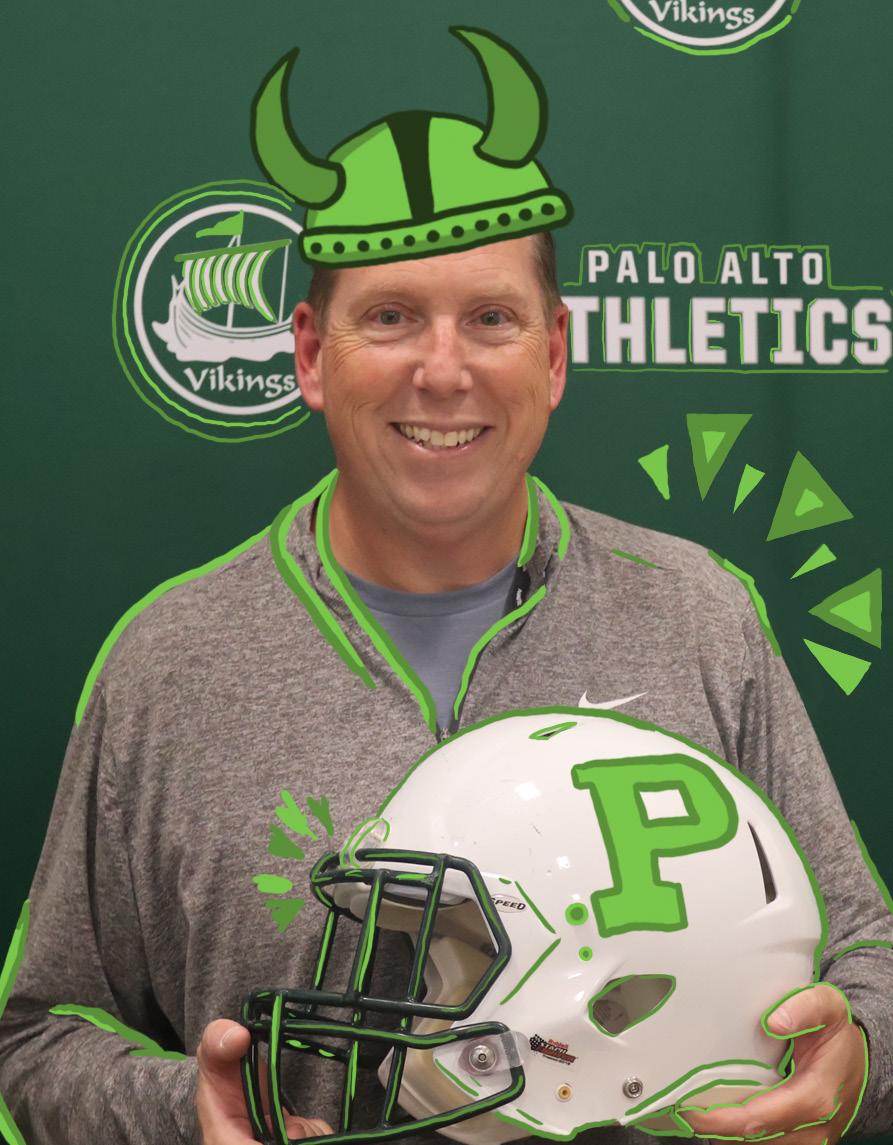
Text by TESSA BERNEY and ETHAN BRADLEY
STUDENTS HAVE SCORED one of the most qualified athletic directors Palo Alto High School has ever seen.
Scott Davis, the new athletic director at Paly, joined this school year following the resignation of former athletic director Jennifer Crane, who moved to Fletcher Middle School.
Having coached softball, soccer, baseball, football and basketball, Davis knows the insand-outs of almost every sport. Knowing how to coach multiple sports is useful, but years of experience in high school administration and college sports will set Davis up for success at Paly.
ble-edged sword for Davis. Even though Davis gained fond memories of beating Stanford in the first game of the year and hearing the coach scold the Stanford team for 45 minutes, he sacrificed time with his family to be there.
“My wife went into labor with our daughter, and I was on a road trip," Davis said. "I'm like, ‘What am I doing?’”
“ I was looking for something that felt right, and the people felt right. It was a place I felt like I wanted to go to every day.”
— SCOTT DAVIS, Paly athletic director
Davis’ extensive background working in high school athletics has helped prepare him for any problem that might arise. In Marin, he was the league commissioner for the Vine Valley Athletic League, the high school athletic league of Marin. Not only was he in charge of seven athletic directors, but he also juggled communication with seven principals, ran all sporting schedules and coordinated championship matches.
Prior to working as league commis sioner, Davis held a successful career as a college basketball coach at Saint Mary’s College of California for 17 years.
“I ended up getting hired as an assis tant at a community college to coach bas ketball,” Davis said. “Then a couple years later, I was the youngest junior college coach in the state.”
Part of being a successful college basketball coach is constantly traveling for away games. This proved to be a dou
This was a pivotal moment in Davis' career, which drove him to explore new opportunities in sports.
As the athletic director, Davis has ambitious goals for the upcoming school year. First, he has improvements planned for a growing sport at Paly: girls’ flag football.
“Next year, we’re probably having a JV [junior varsity] team as well, just because
“If parents can’t come, or grandparents want to see the game, they can watch it online,” Davis said. “That’s something that the lacrosse coaches are talking about right now.”
Secondly, he’s focused on the importance of community.
“[A goal of mine is] to try and get as many students out to games as possible," Davis said. "I think that makes sure your overall four years here are more enjoyable, because you’re connected to something, even if you’re not the ones on the field or court.” v
EARLY RISER — Athletic Director Scott Davis commutes two hours each way to work. Leaving at 6:15 a.m. every day is not everyone's cup of tea, but Davis’ connection with the school is enough to motivate him. “When I walked in the room, it was an instant connection,” Davis said. “I was looking for something that felt right, and the people felt right. It was a place I felt like I wanted to go to every day.”
Photo by TESSA BERNEY

Text by ANGELA FANG and RYAN SAKET
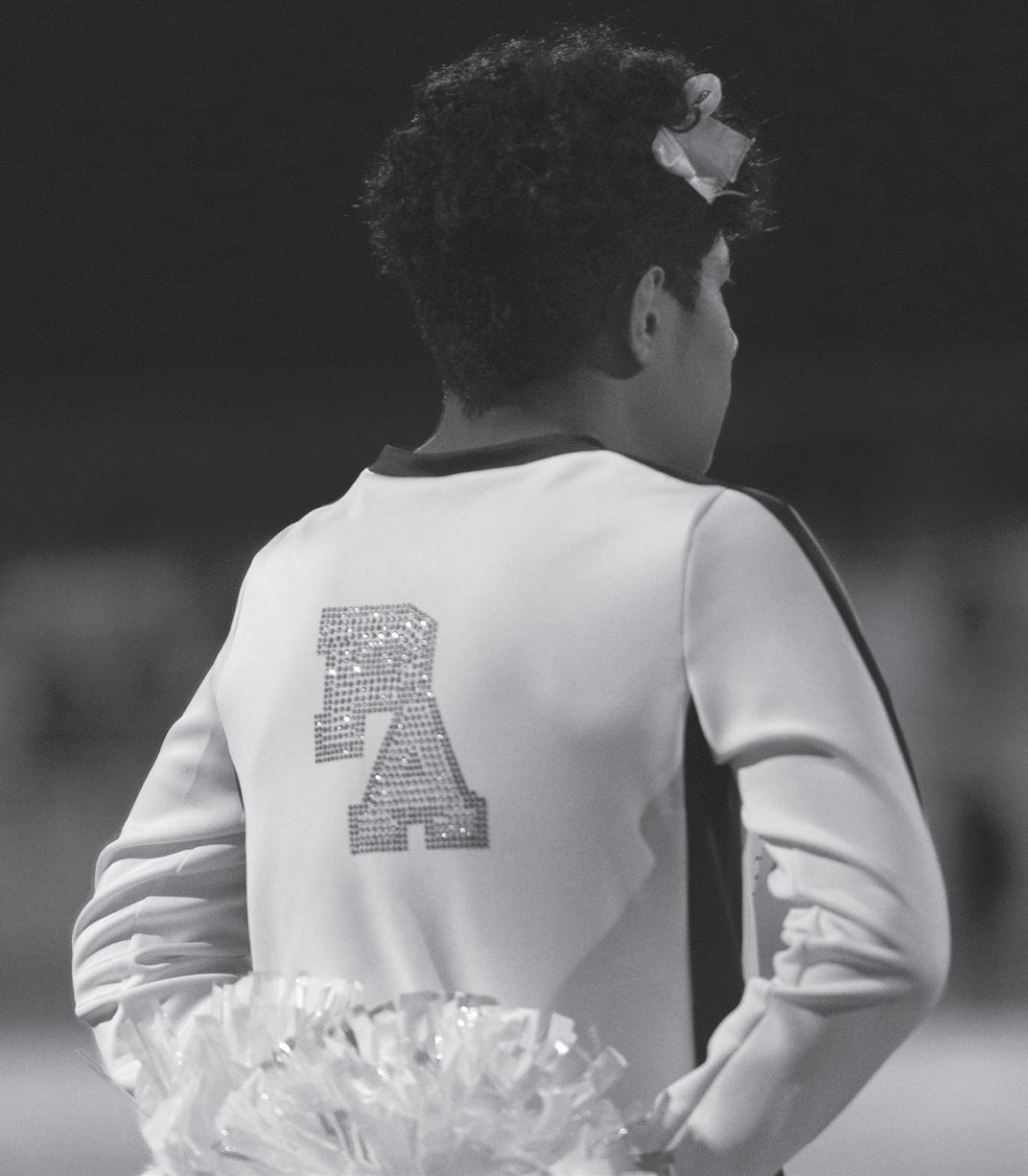
THE DANCE STUDIO COMES ALIVE AS upbeat music blasts from the speakers, where dozens of cheerleaders practice stunts for an upcoming football game.
Among the cluster of cheerleaders in the room, there’s just one boy. As the only male cheerleader on the team, Palo Alto High School sophomore Carmine Unga is challenging long-held stereotypes with his passion, athleticism and joy every time he steps onto the field.
According to a survey conducted during the 2021–2022 school year by the National Federation of State High School Associations, out of the 144,209 competitive high school cheerleaders in the United States, only 3,657 were male, representing barely 2.5% of the sport.

when college-aged men went off to war, ultimately leading to the feminization of cheerleading we see today.
Despite a disproportionately female high school cheer scene, college cheerleading is completely different. According to the University of California, Los Angeles, 50% of college cheerleaders are male.
“I've done my research on cheer before, and I've seen there's a lot of co-ed stuff,” Unga said. “If they can do it, so can I.”
When Unga first joined Paly’s varsity cheerleading team in his freshman year, he didn’t have prior experience with cheer and had just joined the team for fun. But over time, Unga realized that cheer was more than just a sport: it gave him a sense of community.
If they can do it, so can I."
— CARMINE UNGA, Paly sophomore “
Today, the sport is often associated with girls in striped skirts and pompoms. However, organized cheerleading actually emerged as a male-only collegiate sport in the late 1800s, according to USA Cheer. But female participation proliferated during World War II
“I love it [cheer] because it's a great way to really stay close with all of your teammates,” Unga said. “It's really fun to make connections with people you thought you wouldn't ever have to talk to.”
Paly varsity cheerleading coach Helene Gurewitz said Unga’s impact extends beyond his skill.
“His energy is so infectious,” Gurewitz said. “I don't think that anyone who has come across Carmine will leave without a smile.”
Paly senior and stunt captain Katherine Zaner, who has
Photos by SHAURYA THUMMALAPALLI

worked with Unga since his freshman year, said that he has had a positive influence on the team.
“The energy that he brings is unmatched," Zaner said. “He's genuinely such an amazing person.”
Gurewitz said Unga’s role on the team signals a shift in cheer culture, transforming the precedent of who can participate in fe male-dominated activities.
“Representation is really important,” Gurewitz said. “I think [from] him just being out there, other students at Paly can look and be like, ‘oh, I didn't even realize that was an option.’”
Gurewitz hopes to expand the team’s reach to more demographics by hosting open practices, where team members can invite a friend along to introduce them to cheer.
“Hopefully, people will bring their friends of any gender and be able to open up the sport in that way,” Gurewitz said. “It can also be helpful to try and destigmatize and unlearn that institutional sexism and institutional ho mophobia that surround us in society.”
Despite her hopes for breaking ste reotypes, Gurewitz also acknowledged the challenges in doing so.


“They're going to say awful things, but at the end of the day, the team loves Carmine,” Gurewitz said. “And if you see him, say 'hi.' He'll probably say 'hi' back with a big old smile on his face.”
Unga encourages people to consider stepping into roles that go against the norms, and to take a leap of faith.
"Try getting out of your comfort zone and try something new for once,” Unga said. “Don't be afraid to do whatever you want." v
VARSITY STRIPES (FAR LEFT) — Pompoms in hand, Unga sports his green and white uniform. “It would look so much better if we had more boy cheerleaders to represent Paly,” sophomore Carmine Unga said.
ALL SMILES (MIDDLE LEFT) — At a game against San Mateo High School, Unga smiles at the crowd. "He's always been such a positive light and so encouraging," senior Katherine Zaner said.
PREPARE FOR AIR (MIDDLE RIGHT) — During a halftime show, Unga gears up to lift a flyer. “Everyone on the team makes me feel comfortable,” Unga said. "I've had
GET YOUR GAME FACE ON (FAR RIGHT) — Unga tosses his arms back with enthusiasm. “He brings a really fun atmosphere,” coach Helene Gurewitz said.
OOD WORK!” Coach Tim Mulcahy calls from the pool deck to the water polo players treading for their usual warmup.
From playing at University of California, Berkeley in college to beginning his coaching career at the Jane Lathrop Stanford pool, Palo Alto High School Girls Varsity Water Polo Coach Tim Mulcahy knew from an early age that his life would revolve around the sport.

After playing water polo throughout college, Mulcahy took on the role of coaching Paly water polo athletes in 1983. By 1994, he had joined the USA Masters Water Polo team, a nonprofit corporation that provides training for elite athletes to compete at the national level.
Although Mulcahy is now coaching at Paly and competing for a top team, he faced an unexpected setback. Last year, he was forced to step away from the pool after being diagnosed with lymphoma, a cancer of the lymphatic system.
“My family was so supportive and allowed me to not think, ‘maybe it [treatment] won’t work,’” Mulcahy said. “They said, ‘it’s going to work.’”
a soup that had all sorts of incredible vegetables and good products.”
Despite the discomfort that chemotherapy brought, Mulcahy remained patient and focused on his passions.
“During therapy, my goal was to play in Singapore and to coach the kids,” Mulcahy said. “A year after finishing chemo and being in remission, I accomplished both goals, so that gave me something to shoot for.”
Aside from his family’s support, Mulcahy’s water polo players were another key motivator throughout his recovery. They gifted him a ball covered with heartfelt signatures from every member of the team.
“It was so very sweet and so very moving that it helped me get through my recovery and get better and back on the pool deck,” Mulcahy said.
When junior Sabrina Meyers first heard about her coach’s cancer, she was stunned and concerned for him.
“My mom told me a little earlier, and I was really surprised but also scared,” Meyers said.
Senior Estelle Dufour had a similar reaction when hearing about Mulcahy’s cancer.
“I remember I was really shocked and it took me a while to really understand what it meant,” Dufour said. “I’ve never met someone or been so close to someone who had cancer, so I didn’t really know the process.”
Dufour remembered feeling moved when Mulcahy spoke about how important the water polo team was to him.

POOLSIDE APPLAUSE — Tim Mulcahy cheers on the players during warmups. “You might as well focus on this and try to be the best person that you can in this hour, hour and a half, 45 minutes,” Mulcahy said. “I think it’s a life skill that goes way beyond the sport.”
With words of encouragement and superfood dishes, Mulcahy’s family played a crucial role in his journey to recovery.
“My wife was spectacular,” Mulcahy said. “We ate all sorts of cancer-fighting soups and meals. I mean, everything was
“The biggest part that stood out to me about this whole experience was at a team banquet when he expressed how much the team meant to him, mostly after this really difficult year,” Dufour said. “And that really got to me, and I started crying.”
Meyers, whom Mulcahy has coached
since her freshman year, said the support he has given her has not only improved her technique, but also her mentality.
“I didn’t really know what was going on [in freshman year],” Meyers said.” I was the only underclassman on the team, so I was kind of new to the whole thing. Everybody else knew what they were doing, but Tim really
“ I remember I was really shocked and it took me a while to really understand what it meant.”
mindset originated from his own athletic journey. He joined the USA Masters team for water polo so that he could immerse himself even deeper into the sport.

— ESTELLE DUFOUR, Paly water polo senior captain and goalie
“All this time, I’ve been playing internationally in Masters Water Polo and for world championships all over the world,” Mulcahy said.
both USA Masters and high school coaching, it isn’t without its occasional struggles.
“This year, the world championships were in Singapore, and that coincided with the start of Paly’s program,” Mulcahy said. “So I felt like I was torn there because I couldn’t be in two places at one time.”
From coaching to competing to battling cancer, Mulcahy has dealt with many changes throughout his life. But the one thing that has never changed is his unwavering dedication to the sport and his athletes.
“There isn’t any money in this,” Mulcahy said. “For me, there’s not a grand scheme of, ‘oh, I could maybe coach a junior college team next year.’ All that stuff is not what’s motivating me. Motivating me is to see these kids get better and grow as a team.” v
SET OF SIGNATURES — Tim Mulcahy holds a water polo ball signed by the players as a get-well-soon gift, after stepping back temporarily due to chemotherapy. “It was pretty outstanding,” Mulcahy said. “The kids were all so encouraging.”

FROM COMPLIMENTARY des-
serts to drinks, Palo Alto’s wide variety of shops and restaurants have ways to make your upcoming birthday even sweeter. This comprehensive guide offers insight to Palo Alto’s chain stores and small businesses that provide the best birthday freebies. We visited three local hotspots: Stanford Shopping Mall, Downtown Palo Alto and Town and Country Village. In order to guarantee your freebies, make sure to sign up for each store’s rewards program a couple weeks in advance with your email, enter your birthdate and make sure to visit on your birthday!
Stanford Shopping Mall is packed with a variety of restaurants. Here’s our list of the ones that offer birthday free bies.
The Melt offers a free dessert through their app via a one time pro mo code: a chocolate chunk cookie, soft serve ice cream, marshmallow bar or a dark chocolate brownie. Sprinkles gives a free cupcake of your choice available through their apps via a onetime promo code.
Downtown Palo Alto is a charming, small-town area of Palo Alto that ranges from local art galleries to well-known chains.
Starbucks offers a free drink, given that you have made at least one purchase before your birthday each year. This reward is only redeemable on the day of, through the app or in-store.

Coupa Cafe offers a free small birthday coffee from its menu of drinks. The reward can be redeemed in-store via QR code through the rewards app.
Sephora is a cosmetic shop that supplies a wide range of personal care
and beauty products. In order to redeem birthday rewards, customers must sign up for their BeautyInsider rewards program. During a customer’s birthday month, they may get a choice of mini gifts varying from cologne to beauty products. They can be redeemed by either ordering through the app or online with a minimum of a $25 purchase, or going in store to get them for free.


Pinkberry will knock $5 off your purchase. This discount is available through their app via a one-time promo code.
Shake Shack provides a free milkshake for their classic flavors: vanilla, chocolate, strawberry, coffee and caramel. This reward is redeemable through their app, via a one-time promo code.


CUPCAKE — Sprinkles, located at Stanford Shopping Center in Palo Alto, is a chain that sells cupcakes and other baked goods. Pictured is a dark chocolate cupcake, made with Belgian Dark Chocolate cake topped with bittersweet chocolate frosting and chocolate pailettes. Photo: Lilo Sayag
Town and Country Village has been open since the 1950s, serving Palo Alto with an array of lifestyle shops, restaurants, and daily services.
Gott’s Roadside is a family-style diner mainly known for its American cuisine featuring many classics such as burgers and fries. Even without a rewards program, when customers walk into the store and let the cashier know it’s their birthday, a $5.99 ice-cream cone is offered for free with their choice of flavor: vanilla, chocolate or a swirl of

both. Gott’s even allows free customizations with typically 99-cent toppings at the counter.
Jamba Juice offers a small smoothie of your choice for free, that usually costs $9.99. This reward may be redeemed at any store when presenting a QR code at checkout through their rewards app.
Peet’s Coffee also offers a free small drink of your choice on your birthday. This freebie can be redeemed at any store when presenting a QR code at checkout through their rewards app.
ROADSIDE SWEETS Gott’s Roadside at Town and Country Village is an American restaurant that specializes in modern roadside classics. On your birthday, they’ll treat you to a large soft serve cone of either vanilla, chocolate or a swirl of both with the choice of additional toppings. Photo: Lilo Sayag



STRAWBERRY SURF RIDER — Jamba Juice, located at Town and Country Vil lage, is a American juice bar chain that offers blended fruit smoothies and juic es. A small smoothie may be redeemed for your birthday via QR code through their rewards app. Photo: Lilo Sayag


































AFTER ENJOYING A HAM and cheese croissant at one of Town & Country’s tiny outdoor tables, Palo Alto High School senior Camilla Luz opens the trending food rating app, Beli. She carefully considers Douce France’s ambiance, service and flavors before rating the French cafe an 8.9 out of 10. Douce France is now her second-highest-ranked restaurant on Beli. Beli, the food-focused social media




eted in popularity among Generation Z and Millennials. Beli’s Instagram account reported that users posted a total of 30 million reviews in 2024, surpassing its 20-yearold competitor Yelp, which produced just 21 million reviews. Beli serves as a platform for users to rate eateries anywhere in the world and post their dining experiences for friends to see on their feeds.







One of the app’s key features is the ability to post photos, allowing users like Luz to share their finds with food lovers and inspire others to try new spots.

onto an app where people care about food.”



“I love taking pictures of my food,” Luz said. “Now I can upload my photos
Unlike traditional reviews, on Beli, users simply indicate ‘I liked it!’, ‘It was fine’ or ‘I didn’t like it’. Then, in a series of thisor-that comparisons to restaurants users have already ranked, Beli creates a numerical value out of 10. Paly senior Alice Sheffer says the system makes the rating process much easier.



“I don’t know what I’d give [a restaurant] on a scale of 10,” Sheffer said. “But [when] you rank them in comparison to each other, I know that.”


From hip cafes to local mom-and-pop shops, Beli acts as a go-to guide and helps users scout out popular places in town.








Beli initially took off in tight-knit communities like college towns, which was the case for second-year Foothill College student and Verde alumnus Austin Fujii, who was introduced to the app by a friend in 2025.

As Palo Alto’s third-most prolific reviewer, Fujii said connecting with friends on the app is interesting because it provides him with food suggestions from anywhere.









“Beli succeeds more in appealing to students who have social networks beyond just their home or college town,” Fujii said. “College students are from all over the country and world, not to mention how often college students travel on road trips, cheap weekend flights or even study abroad programs.”



Despite this, Paly senior Amalia Tormala chooses not to climb leaderboards and instead emphasizes the collaborative feel of the Beli community.


“There’s not, at least in my experience, a competitive Beli culture,” Tormala said. “It’s just people who enjoy food sharing their recommendations with other people. That’s what I like about it.”









According to Beli’s founders, over 80% of their user base is under 35 years old. Fujii says he believes young people are attracted to Beli over other food-reviewing sites.




Beli’s laid-back nature distinguishes itself from traditional social media apps and makes it a platform students reach for with little hesitation.


“On Beli, there’s less social interaction, and it’s more about seeing what your friends are up to,” Tormala said. “It’s more about just admiring what everyone is doing, and there’s no judgment passed.”





“People can go straight to Beli first because they can see their friends’ advice instead of gambling on the reviews of people they’ve never met.”


Tormala says she believes that Beli has changed the future of dining out.



— AUSTIN FUJII, Foothill College food connoisseur

“People will always eat,” Tormala said. “Beli will not die out anytime soon, but I do believe that competitors will start to come, and that will diminish Beli’s popularity. Right now, it’s the only app of its kind.”


“For Gen Z specifically, Beli seems like the new version of Yelp influenced by familiar elements of social media,” Fujii said. “Instead of sifting through Google Maps or Yelp reviews, people can go straight to Beli first because they can see their friends’ advice instead of gambling on the reviews of people they’ve never met.”




Because of their young user base, Beli may not appeal to all ages equally. Paly physics teacher and self-described foodie Michael Lupoli said older users might not fully grasp Beli’s culture.





“A lot of this app screams younger generation to me just because of the way the app is set up,” Lupoli said. “The language used in the app is language that younger people might use, and social media in general targets younger generations.”

At first glance, Beli may just appear as another colorful platform to leave restaurant reviews on. But for some, it’s a digital diary of meals out, complete with sweet snapshots and timestamps, making Beli a heartfelt way to capture sentimental moments.

“Beli is another form of remembering aspects of your life and memorializing events and time spent with close friends,” Sheffer said. “We all like to keep track of things that we do.” v


Based on individual rankings, Beli builds a personalized taste profile for every user. Users can also create their own ranked lists while competing on the gamified interface to visit the most spots in a single city.









1: Give your general opinion of the restaurant





STEP 2: You can tag friends, write a review or add photos









STEP 3: Compare with different restaurants








STEP 4: Beli will calculate a rating based on your choices!





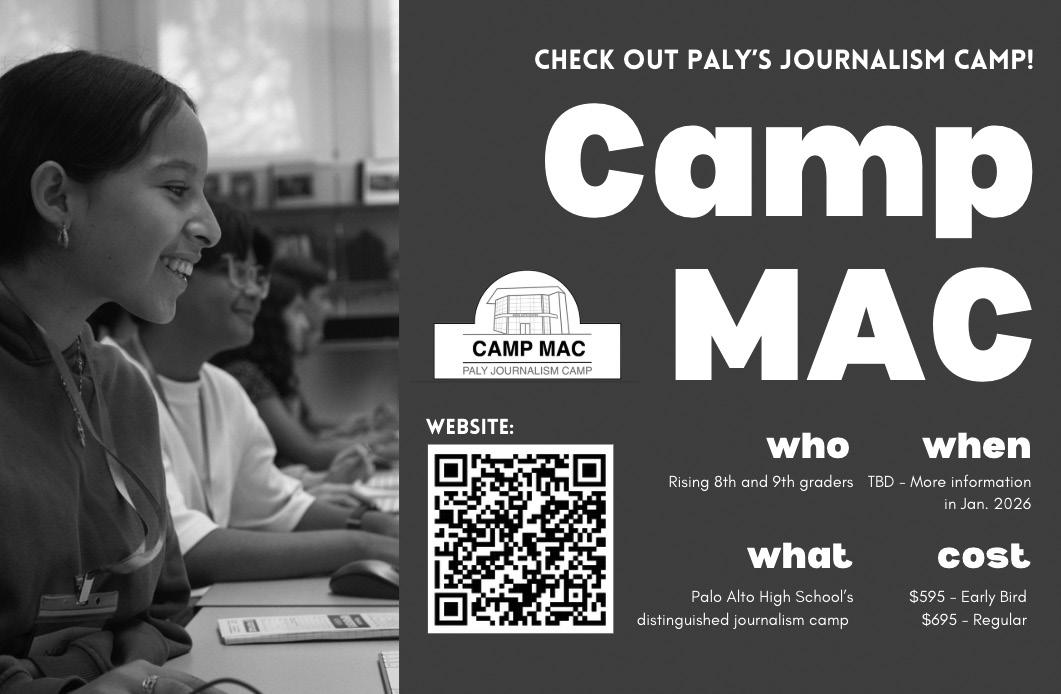


WARM ORANGE LIGHT POURS through the entrance as the sounds of casual conversations and background music fill the room. Decorative wood pillars line the space, and a wall of textured golden panels sections the doorway from sleek furniture. With floor-toceiling windows blanketing the diner in natural light, Horsefeather is the newest addition to Town & Country Village’s diverse and esteemed lineup of restaurants.
Horsefeather opened its first location in San Francisco in 2016 and recently launched its Palo Alto branch on June 27. The team has lofty goals for the upcoming years, including outdoor seating, an expanded menu and a new lunch program for Paly students.
“We’re working on a kind of grab-and-go situation for Palo Alto High School [students],” General Manager Dzu Nguyen said. “Foods that you see on the menu are going to be rapid fire for you guys.”
Nguyen said the inspiration for the restaurant’s cuisine originated from a fusion of cultures.
“We like to term it as ‘Pan Californian,’ with a focus on Latin and Asian influence,” Nguyen said. “Our chef Johanna is Yucatanian and Mexican. By birth, I’m Vietnamese. Our owners are Chinese. [We look for] the middle ground in between those flavor profiles.”
The story behind the restaurant’s name refers to the term “horsefeathers,” which means nonsense or something ridiculous,

As one of the most popular items on the menu, the wings were large and meaty. At first glance, the shiny, sweet and sour glaze paired with the uneven texture of the skin made each bite one to look forward to. The layer of crust was thinner than expected, cracking into tiny bits and revealing the tender, juicy chicken inside. The honey and sesame oil sauce was messy but succulent, encouraging us to lick our fingers to ensure none of it went to waste. The Korean Crispy Wings were the best of the bunch and were well worth it.
CULINARY CARE (RIGHT) — A chef prepares Horsefeather’s specialty fries at lunchtime. “I work very closely with Chef Johanna, and we’re always tasting the food ... the creative process always comes in with seasonality as the goal,” General Manager Dzu Nguyen said. Photo: Shaurya Thummalapalli
VIBRANT VISITORS (FAR-RIGHT) — Two customers cheerfully sit at the bar while talking. “We want people to immediately feel comfortable when they come in,” Nguyen said. Photo: Shaurya Thummalapalli
contrasting its put together exterior.
“Essentially, [the name is] a joke; it kind of falls into the ethos of our restaurant,” Nguyen said. “We present ourselves in the best way possible, with great service and high quality, but at the same time, we’re still always going to have that sort of neighborhood-style energy, that kind of devil-may-care attitude.”
We decided to test if Horsefeather’s food lived up to its reputation on a late Friday afternoon. At 4:30 p.m., the restaurant was not busy, missing the usual bustle of servers and customers moving about.
We walked past rows of wooden chairs, stone-topped tables and a sophisticated, stylish bar, furnished with dark-oak shelves containing numerous alcoholic beverages.
The menu featured six appetizers ranging from $11 to $28, along with 10 main dishes ranging from $18 to $36. Our food arrived just 10 minutes after ordering.
From start to finish, Horsefeather demonstrated its expertise in creating flavorful and mouthwatering dishes, but also performing above and beyond with its pleasant atmosphere, comfortable seating and top-notch service. With a broad selection of cocktails and main courses that go for above $20, you are more likely to find young adults and customers who can afford the restaurant’s higher prices. Offering diverse, appetizing options for both brunch and dinner, Horsefeather is a spot that all Palo Alto residents should visit. v


This dish held three tacos with two small bowls of coleslaw and red salsa. Each taco had plenty of pulled pork, pickled onions and cilantro inside. We recommend you eat the tacos quickly, as the tortilla was slightly soggy by the time we got to them. The fatty pork made for some satisfying bites paired with the acidic onions as they simultaneously clashed with the plainness of the tortilla. The coleslaw had an enjoyable sour taste, while the salsa was very spicy, complementing the tacos.


The large bowl of Duck Fat Fries was an excellent start to the dinner. Each fry was topped with a red umami seasoning and grated duck fat, which had a snow-like texture that melted at the touch. The fries were small with a light crunch, while the sweet curried ketchup matched their saltiness well. The fries are arguably the best deal at Horsefeather, enough to satisfy a party of six all for a low price.
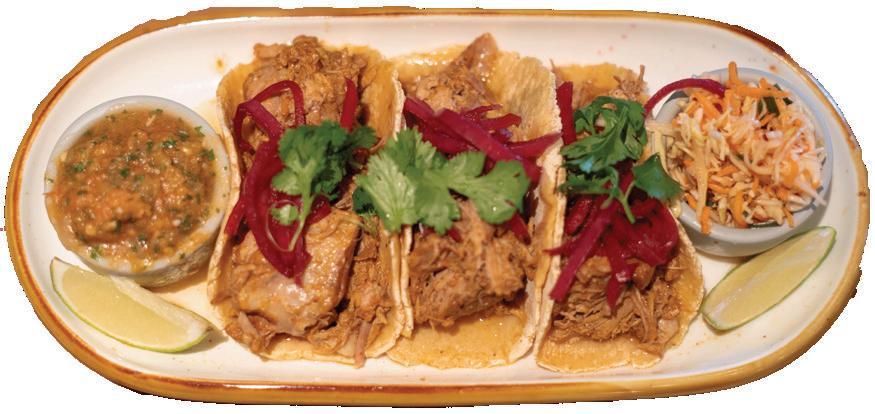
After the meal, our server laid out six spoons in a neat row, reflecting Horsefeather’s attention to detail. Our dessert arrived in a parfait glass, topped with a decorative mint leaf, a viola flower and a handful of fresh berries. The Yuzu Custard delighted the taste buds with gentle sweetness and a citrusy tang. Soft whipped cream was layered on top of the airy, fluffy custard, which was light and refreshing. The garnish and berries added complexity to an otherwise simple dish, successfully cleansing our palates after a spice-packed dinner.

Text by YARDENNE STERNHEIM
Learning through Socratic seminars is important for education because it allows students to think more deeply about what they’re reading. It gives them a chance to slow down and focus on one thing through organic thought, sparking thoughtful discussion.
It’s rare to have an experience like this to sit with open minded people and have civil discussion.
KNOWING YOURSELF is the beginning of all wisdom,” I read aloud Aristotle’s quote written in bold on the agenda spreadsheet.
Sitting at my desk, thinking about those words, I felt a sort of connection.
The decisions you make, relationships you build and your personal philosophy is all based on how much you know yourself.
I believe knowing and understanding oneself is the foundation of everything one does. True understanding of oneself is the basis of free will and reason.
Over the summer, I had the opportunity to travel to Chicago for a week, participating in a program called The Great Connections Seminar. The course was based on Socratic seminars.
The Socratic discussion method is a way of learning for students and people where everyone sits in a circle and discusses a text and its meaning.
Socrates was a philosopher in ancient Greece. He would walk around the “Agora” or main marketplace and talk to people, constantly asking them open-ended questions to get them thinking.
At the program we read texts and poems by famous authors, entrepreneurs and intellectuals, analyzing writing and coming up with questions to discuss. The goal of this Socratic discussion process was to encourage understanding of the writing and context of a piece.
To me, the experience felt very different from a conventional high school class, where students are lectured and oftentimes told what to think. I was able to learn to interpret the texts in my own way and not be lazy with my reading.
The program was founded and run by author and educational entrepreneur, Marsha Familiaro Enright, who brings together a select group of high school and college students through an application with an interview every year.
A friend of mine who had done the program last summer told me about it, and she had really enjoyed her time there. So I went out on a whim and did it.
The program created many firsts for me. At first, the experience was nervewracking because I was so unfamiliar with everything: my first flight alone, my first time completely away from home without relatives, my first time staying in dorms and my first time in a new city with strangers.
The program taught me that while things may be hard to figure out in the beginning, like where baggage claim is, I can always work to figure it out. This happens when I present myself with confidence.
The program consisted of two to three Socratic discussions daily. The assignments, to prepare for the discussions, were to read texts and papers from the Great Books written by philosophers and intellectuals,
including, Aristotle’s “Four Causes and DeAnima,” Ayn Rand’s “Philosophy: Who Needs It” and “The Objectivist Ethics,” James Madison’s “Federalist Paper No. 51,” and Montesquieu’s “Spirit of Laws” and many more.
While each of the texts were individual, they all connected to the broader theme of reason and free will. I liked the variety of different papers that were read, and as I was reading them, I was able to make connections between the different writings to each other.
Every morning we would gather at my dormitory piano room, to discuss a text’s

purpose for a couple of hours.
One of the texts that were read was written by Enright herself, which was interesting because it provided me with a direct perspective.
Her writing discussed the importance of introspection, which is the act of knowing one’s own thoughts and feelings through rational thought, self-reflection and self-observation. They stimulated deep discussion on the meaning of introspection.
Through the Socratic method of being in a circle with peers in discussion, I felt that it was a helpful way for me to absorb the purpose of what I was reading, as compared to the way I would’ve approached a

The most memorable reading we discussed was Maria Montessori’s “The Secret of Childhood.” This was a chapter from Montessori’s memoir, about her establishment of a school.
It was incredible and inspirational to read because one woman’s ideas changed the lives of millions of people through education.
In her writing, Montessori highlights how much she valued the education that children received.
It moved me because it’s not felt often that I feel that teachers really care about their teaching, that Montessori’s teaching is a learning method that has spread globally benefitting millions of people.
participate in the discussions and ask me questions both gave me more opportunities to participate, but also allowed me to ask my own questions and gain understanding. Them asking me questions gave me more of an opening to give my insight.
Many students get nervous about Socratic discussions and having to participate. I felt the same way at the beginning of the program.
During the discussions, it was harder for me to participate because there was so much information and different perspectives that people were giving that I was trying to sort out in my mind.
My intuition for speaking up for myself rather than letting things slide became stronger.
After reading this, it gave me a sense of aspiration to take action in children’s education.
While most of the discussion is student-led, it is kicked off and monitored by a teacher or “guide.” They provide students with questions and help students come up with their own.
The texts that we read were heavy and hard to understand, like the paragraph on selection of property from Locke’s “Second Treatise on Government” because the dense paragraph content and references were complicated.
It felt intimidating and unmotivating to read and learn about at first. But the way we analyzed and discussed them strengthened my understanding and critical thinking skills.
The discussions have made me more confident with my writing and reading of dense boks back at school.
Having staff members at the program
I also didn’t feel very confident. I felt sometimes that I would be wrong with what I had to say.
I find that Socratic seminars are the best way to engage students and learners in any subject.
It can be intimidating, but it’s incredibly rewarding, opening up thoughts and processes that a student wouldn’t have normally been aware that they had.
Socratic discussion enables students to ask questions and lead their own learning.
Just during regular conversation with my peers, it motivated me to speak up and share my thoughts with others. Students get a sense of self agency and creativity in their participation.
The Great Connections program helped me find my full sense of agency, whether it was during the whole group discussions or during small conversations. My intuition for speaking up for myself rather than letting things slide became stronger, and I found that I could successfully know myself better. v
Text and photos by JULIE
YANG
CAN I BUY A COOKIE?”
I jumped at the voice of a middle-aged woman, caught completely off guard. I ended up staring at her a little too long because I was at a loss of words for her thinking I was part of Girl Scouts.
I was first asked this question four years ago in seventh grade, when I joined Scouting America, previously known as Boy Scouts of America. With my newly bought scouting uniform plastered onto my body, I nervously marched up and down my neighborhood selling Christmas wreaths for the organization’s annual fundraiser, anxious to approach strangers’ front steps.
That woman was unaware of the changes Scouting has implemented over the years, and I don’t blame her. Scout-

ing has historically had a reputation as a male-dominated organization until 2019, when they began accepting all genders.
Before the organization’s decision to embrace inclusivity, Girl Scouts was the ideal program for females to join. It was founded in 1912, just two years after Boy Scouts of America was established. Boy Scouts emphasized outdoor skills and leadership, while Girl Scouts focused on more “womanly undertakings,” such as sewing and cooking.
Back then, I nervously laughed off the woman’s question and quickly corrected her, because I was embarrassed that someone mistook me for a Girl Scout. However, as the misinterpretation of the correct organization I belonged to persisted, I began wanting to prove that girls are actually capable of the same accomplishments and activities as boys.

cross-gender activities. This stereotype has been deeply rooted in our nation’s old beliefs and in the formation of this organization.
As Americans began to prioritize gender inclusivity and parents strived for their kids to try new hobbies, Boy Scouts gave in to the pressures from society to reform. Now, nearly 200,000 of over one million members are girls.
As a result of the scouts now accepting all genders, many girls like me are able to find where they belong in the community.
During the time when the organization was still called Boy Scouts of America, girls were excluded from many activities and social organizations that boys attended and participated in. Different genders were expected to maintain a particular persona that prohibited


As a result of the scouts now accepting all genders, many girls like me are able to find where they belong in the community. This sense of belonging resonated with me throughout my scouting journey. When I was younger, I fit into the conventional tomboy description. Since I grew up closely with my younger brother, I was always drawn to more sporty and soiled hobbies, like baseball and hiking, over more feminine activities. I yearned for nature and was always excited for my family’s annual national park camping trips.
So when I was deciding on a new extracurricular after the pandemic, the choice of Scouts was clear to me.
I joined the program at a time when many pioneering female founders of our nation’s first girl troops were still active in the organization, making me proud to carry on their legacy. My first year out of the program was slow to start, but nonetheless rewarding. Within the scouting system there was a series of requirements that tests Scouts on different wilderness and life management capabilities.
While many Scouts my age were rushing through the ranks, I wanted to step back and enjoy each moment of the process. I worked on each requirement thoroughly and applied them to my own environment

both during outings and in everyday life to the best of my ability. I was also finally able to fulfill my long-awaited desires to partic ipate in backpacking trips, watersports and snow sheltering.
Each one of these adventures holds its own special memory that I still treasure ev erywhere I go.
My patience has also led me to learn ing from some of the most devoted teen age and adult leaders through outings and Scouting programs. I have acquired various life and technical skills from taking leadership roles to guiding younger scouts within the organization, which enhanced my connection building abilities, relating to others on a deeper level.

Each one of these adventures own special memory that I still treasure everywhere I go.
I recall an outing during my term as a Den Chief, a Scout who mentors younger Cub Scouts, where I was in charge of co-leading a hike through a water cave. It was a chance to take an initiative in that hike by honing not only my orienteering skills but also being dependable in a situation where twenty restless Cub Scouts were susceptible to injuries.
Simultaneously, I was able to overcome my fear of talking to strangers, which
nizing the installation of a pollinator low water-use garden for a nonprofit produce organization, the Almost Eden Garden Project. It was a hefty amount of labor and perseverance from everyone that volunteered to help. But walking away from it, I felt accomplished that I made an impact on my community.
Scouting allowed me to embrace my adventurous side in a world often dominated by pressures to succeed and to stick to routine. It is a program worth protecting for girls so that future generations can discover their own passions.
But the impact of Scouting extends be-
All around us, we can see females in career paths that were once considered unattainable: from leading in science and technology, to serving in the military, to holding the highest offices in government and business.
Organizations like Scouting of America are the stepping stones of a future that will continue inspiring little girls and boys to take that leap forward together, united as one. v
Text by STEFAN ERIKSSON
EVERY SUMMER, for as long as I can remember, I have traveled over the Atlantic to visit the distant countryside of Sweden. To me, Sweden is a paradise — a place where joy never seems to end. The endless bathing in perfect summer water, card games that stretch late into the night and scenery that feels unreal everywhere I look. Most of all, I cherish the time I get to spend with my family whom I rarely see, surrounding myself with people that make me want to come back the second I step back onto the airplane. That’s the Sweden I know: timeless, safe and perfect.
That’s why I was shocked when I started hearing about the other side of Sweden. Stories of bombings, shootings and other crime felt unreal to me — it didn’t sound like the lakeside paradise I thought I knew. Suddenly, Sweden felt unfamiliar, and now I have a different image of the country.
Researchers argue that these problems are in part due to Sweden’s failure to integrate migrants, which sometimes leaves unresolved cultural differences that spill over into crime and unrest. One
sensitive area is gender norms. When migrants come from environments with stricter views of women, their values can clash with Sweden’s progressive culture.
One example is in the World Economic Forum’s Global Gender Gap Index (2024), which found that many of the lowest-ranked countries for gender equality were countries where Sweden has received large numbers of migrants from.
If integration is weak, differences in cultural and gender norms may persist. In practice, this means the Swedish government needs to actively address attitudes around gender, consent and equality to prevent long-term cultural divides. This can be done through strong integration efforts.
The results can be seen in crime statistics, such as a study conducted over 21 years by researchers at Lund University which found disparities in conviction rates for people of immigrant backgrounds, even after adjusting for socioeconomic factors. In the most extreme case, men who immigrated to Sweden after their 15th birthday were more than six times as likely to be convicted of rape compared to native Swedes.

The researchers emphasized that further research needs to be done to understand why the discrepancy exists.
In addition, a United Nations multi-country study in Asia and the Pacific found that attitudes around masculinity and dominance were key drivers of sexual violence, suggesting that cultural values, not just economics, played a role.
Henrik Emilsson, a researcher at Malmö University focused on migration and integration policies, explained that Sweden has invested heavily in programs to help migrants adapt. He noted that the country requires newcomers to participate in a two-year integration program that combines cultural education and labor market training.
“If you get protection status, you get paid to do a two-year integration program,”

FISHING ON THE LAKE — My family and I go on a fishing trip in Skinskatteberg, Sweden. In this particular lake “abborre” and “gädda” are common fish. Photo: Jennifer Eriksson
Emilsson said. “You learn about Swedish culture and you do some labor market training.”
I believe that most migrants are doing well and are a net positive to Sweden. But those who aren’t paint the whole group as doing poorly. Emilsson agrees.
“About 10% of the migrant group are doing less well, and if we have over one million refugees, that becomes quite a large number,” Emilsson said.
The 10% Emilsson refers to often face challenges in the labor market and cultural integration. As a result, this struggling minority is often linked to crime and unrest in public debate.
This doesn’t mean that migrants are destined to commit crimes—most do not. But it does show that ignoring cultural integration is dangerous.
As time went on, the Swedish government eventually discovered that the best course of action was to heavily reduce the influx of migrants.
“Since about 10 years back, the Swedish government has been doing everything
Art by ETHAN BRADLEY

they can to reduce migration,” Emilsson said. “They’ve completely changed their minds.”
Denmark, Sweden’s neighbor, handled immigration differently. They forced integration, leading to significantly different outcomes.
The Danish government, aware of potential problems, introduced the Integration Act of 1999 which focused on assimilation into the labor market and culture.
One way they achieve their goals is by requiring migrants to sign individual integration contracts—a practice which began in 2006. Migrants take required language classes, participate in the labor market, learn Danish culture and aim to be financially independent by the end of the contract. If they break the contract, their benefits are reduced. In contrast to Sweden, Danish migrants’ benefits are also kept low to encourage financial independence.
As a result, Denmark has reported stronger integration outcomes, which is reflected in their safety statistics. According to the Global Peace Index by the Institute
for Economics and Peace, Denmark ranks fifth out of European countries in safety, while Sweden is ranked at 30. Denmark took the trade-off of keeping their citizens safer at the cost of offering the same humanitarian openness that Sweden initially provided.
Sweden would have benefited from a stronger emphasis on assimilation early on, in addition to enforcement of full participation. This would include additional support for those who want to contribute, and limited support for those who do not.
My family in Sweden is also concerned. In America, pro-immigration stances are seen as liberal, while anti-immigration stances are seen as conservative. My family in Sweden is very left-leaning, but they also have strong criticisms of Sweden’s migration policies. Still, compared to the U.S., immigration in Sweden deserves more nuance. Sweden has one of the most generous welfare programs in the world, and uncontrolled migration puts pressure on the system. Additionally, Sweden is very progressive, and many Swedes see immigra-
tion from countries with different gender norms as a step in the wrong direction with regards to women’s safety and independence.
To give credit, helping migrants from war-torn countries is a very noble cause, and that’s what Sweden wanted to do. They aimed to use their wealth to positively impact others in worse situations.
Migrants are an essential part of a country, and many great nations have been built on the backs of immigrants. I support migration and acknowledge that there are many positives to it. However, when a country fails to plan like Sweden did, it causes irrevocable consequences.
Next summer, when I go to college, I may study in Sweden. I know this time I won’t be safeguarded by the distant countryside. I’ll probably enjoy the same candy, swim in the same lakes and play card games late into the night, but beyond the countryside, I will still have this other side of Sweden in my mind: a nation that is not only a paradise, but a nation also wrestling with change. v
Palo Alto Unified School District
Palo Alto High School
50 Embarcadero Road
Palo Alto, CA, 94301
